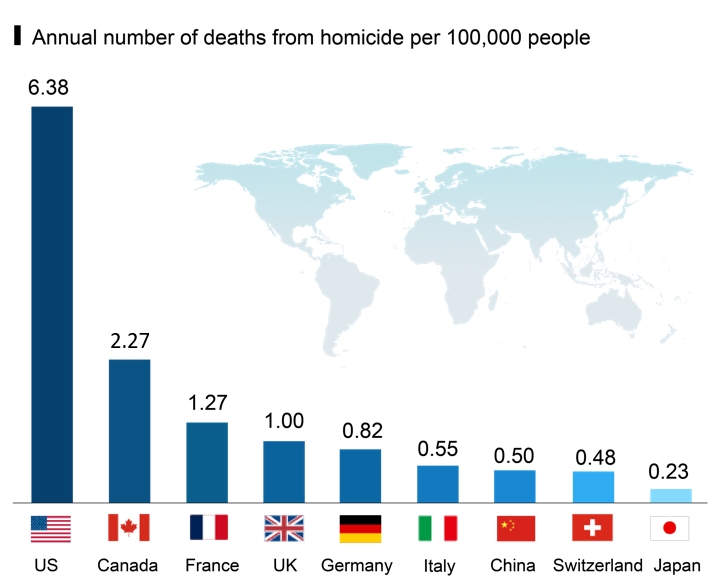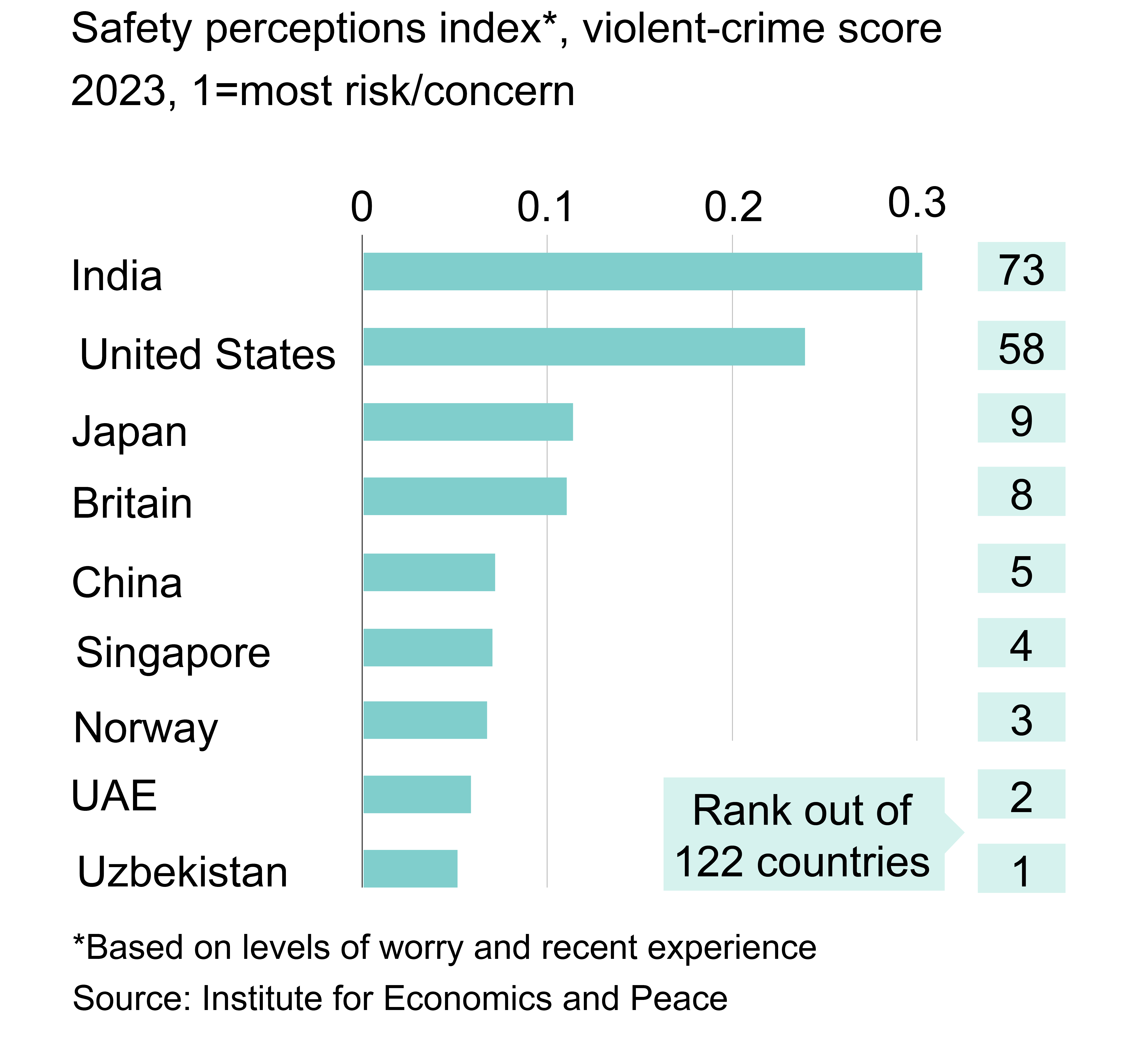
If you search “China Travel” on social network today, such as Youtube or TikTok, you are likely to encounter influencers travelling in China amazed by how safe the country is, and how they can walk alone at midnight in the urban areas of a Chinese megacity, without the fear of robbery or other violent crimes.
The numbers also support their claim. In 2023, China reported approximately 4.5 million criminal incidents, which translates to a crime rate of about 321 per 100,000 people based on its population of around 1.4 billion. The same year, FBI reported a violent crime rate of approximately 363.8 per 100,000 people in the US, with a significant decrease of 12% in murders compared to the previous year.

Homicide rate in selected countries. Source: UN Office on Drug & Crime
But perhaps the most remarkable is the homicide rate. China's homicide rate in 2023 was recorded at mere 0.46 per 100,000 people. By contrast, the global average homicide rate is estimated at around 6.1 per 100,000 people, with countries like the United States reporting rates as high as 6.38 per 100,000.

China is clearly an outlier in crime rate especially when compared with countries with the same income level. A number of studies have been dedicated to uncover the factors contributing to China’s relatively low crime rate.
Delving into the complexity of crime rates in China, a 2022 study sheds light on the intricate interplay between socioeconomic factors and criminal activities. Conducted by scholars from The University of Sydney, the research spans three decades, scrutinizing the impacts of education levels, unemployment rates, and major events on crime rates in the Chinese mainland and Hong Kong.
The researchers analyze panel data spanning from 1990 to 2020, sourced from the National Bureau of Statistics and Hong Kong's Census and Statistics Department. By examining variables such as GDP, CPI, urban unemployment rate, education rate, and divorce rate, they construct empirical models to unravel the complexities of crime trends.
They discover a significant correlation between education levels and crime rates, indicating that enhancing the overall education standard could play a pivotal role in reducing criminal activities. Surprisingly, the study uncovers a counterintuitive relationship between urban unemployment rates and crime, suggesting that in the context of urbanization processes, higher unemployment may not necessarily lead to increased crime rates as traditionally assumed.
Moreover, the study highlights a substantial decrease in crime rates in the Chinese mainland following this legislative change, underscoring the profound influence of legal reforms on societal behaviors. Intriguingly, the research also examines the return of Hong Kong in 1997 and its relatively minor effect on crime rates in the region, providing nuanced insights into the diverse dynamics shaping criminal trends in these distinct social systems.
Apart from education, economic factors certainly play a role in crime rate. A recent study challenges the long-held belief that income inequality is the primary driver of violent crime. Researchers analyzing homicide data from Chinese courts between 2014 and 2016 found a strong correlation between poverty and homicide rates at the prefecture level—a finding that holds even when controlling for income inequality.
The study utilized a unique dataset: all first-instance court verdicts for homicide cases. Combined with income distribution data from the 2005 mini-census, the researchers were able to paint a detailed picture of the relationship between economic factors and violent crime across China's diverse prefectures.
Their analysis revealed that absolute deprivation, not relative deprivation (the feeling of being disadvantaged compared to others), is the key factor. Higher poverty rates, both in urban and rural areas, significantly predicted increased homicide rates. Interestingly, higher average income in urban areas acted as a "pull" factor, attracting crime to those regions.
The study also sheds light on the impact of internal migration. Migrants from high-crime areas contributed to increased homicide rates in their destination cities, highlighting the complex interplay between geographic mobility and crime.
This research offers crucial insights for policymakers in China and around the world. Focusing solely on income inequality as a crime prevention strategy may be misguided. Addressing poverty directly, through targeted interventions and social support programs, may prove more effective in reducing violent crime in China. Perhaps this finding can partly explain China’s low homicide rate: during the past decades, it has lifted nearly 800 million of its citizens out of poverty.
In a digital age where surveillance debates often evoke Orwellian fears, a 2018 national survey in China provides a surprising revelation: a significant majority of Chinese citizens express strong backing for various forms of state monitoring. Contrary to assumptions, the study unveils a landscape where support for surveillance measures aligns with broader societal values.
The survey reveals an overwhelming endorsement for CCTV surveillance, with a staggering 82.2% of respondents expressing approval. Following closely behind is support for e-mail and Internet monitoring, resonating with 61.1% of those surveyed. Even the most comprehensive policy of intelligence gathering on all citizens garners positive feedback from over 53% of the population.
Interestingly, the study delves into the factors shaping this endorsement. It uncovers that individuals who prioritize social stability, express satisfaction with the government, and, to a lesser degree, exhibit trust in government institutions, are more likely to support surveillance initiatives. Unlike in Western contexts, where concerns over privacy breaches and counterterrorism efforts influence public opinion, these factors hold lesser significance in shaping attitudes toward surveillance in China.
But do these surveillance measures actually contribute to the low crime rate rather than just a placebo for feeling safe?
In a recent study conducted by a team of researchers from Peking University and Tsinghua University, the impact of surveillance cameras on crime rates in China has been rigorously examined and quantified. They utilized novel data from China between 2014 and 2019, leveraging textual analysis techniques to analyze crime rates and camera density. By applying instrumental variable methods, the team addressed endogeneity concerns and established a causal relationship between surveillance camera installations and crime reduction.
Their key findings are:
Significant Crime Reduction: The study reveals that cities with denser surveillance networks experienced substantial declines in crime rates. The reduction was particularly pronounced for publicly visible crimes such as drug-related offenses, robbery, theft, fraud, and violence.
Positive Socioeconomic Effects: The increased deployment of surveillance cameras led to higher satisfaction with the government, enhanced sense of security, and behavioral changes such as increased outdoor exercise and longer working hours, especially among women.
Cost-Effectiveness: The study estimates that preventing a single crime through the installation of surveillance cameras costs approximately $5,922, showcasing the cost-effectiveness of such measures compared to other countries.
These findings have significant implications for policymakers and law enforcement agencies globally and underscore the effectiveness of surveillance cameras in deterring crime, enhancing public safety, and generating positive socioeconomic outcomes.
The presence of surveillance camera might even change the behavior of law-obeying citizens in an effort to prevent crime. A 2024 study has examined the relationship between surveillance cameras and public cooperation with the police in China. The study investigated how surveillance videos impact the willingness of Chinese residents to collaborate with law enforcement.
The research, based on face-to-face survey interviews with 751 individuals in a southern Chinese city, revealed that the presence of surveillance cameras has a positive influence on public cooperation with the police. Particularly noteworthy was the finding that individuals living in neighborhoods characterized by high levels of collective efficacy and those perceiving low levels of police fairness were most affected by the cooperation-promoting effect of surveillance cameras.
Furthermore, the study underscored the significance of police fairness and effectiveness in shaping public willingness to cooperate. It highlighted that individuals are more inclined to assist the police when they have trust in the capabilities and treatment of law enforcement officials.
The implications of this research suggest that the extensive use of surveillance cameras in China can serve as a crucial factor in encouraging public support for law enforcement activities. By emphasizing the importance of both informal and formal social control mechanisms in influencing public cooperation, the study raises important questions about balancing the benefits of surveillance cameras with concerns surrounding privacy and governmental control.
For centuries, the teachings of Confucius have shaped the moral and social fabric of China, embedding values that continue to define societal norms. From family relationships to governance and justice, Confucian principles have created a unique framework for harmony—one that plays a critical role in maintaining China’s remarkably low crime rates.
At the heart of Confucianism lies its emphasis on hierarchical relationships, family loyalty, and moral virtue. These principles serve as a moral compass for individuals, helping to guide decisions and social interactions.
Additionally, Confucian teachings place a strong emphasis on respect for authority and societal hierarchy. From government leaders to elders within the family, the idea that harmony stems from an orderly structure is deeply ingrained. This respect fosters a sense of duty and discourages behaviors that might disrupt social stability. People are taught to internalize the importance of preserving order, making criminal behavior not just a legal violation, but a moral failing.
In Confucian thought, family is viewed as the cornerstone of society. The concept of filial piety—a deep respect and devotion to one’s parents and ancestors—creates a moral obligation to uphold family honor. For many, the fear of bringing shame to one’s family serves as a powerful deterrent against wrongdoing. Research has shown that children raised in authoritative yet supportive family environments, consistent with Confucian ideals, are less likely to engage in delinquency.
Unlike Western cultures that often emphasize guilt as an internal moral compass, Confucianism leans heavily on shame as a social deterrent. In this context, an individual’s actions are seen as a reflection of their family and community. The prospect of losing face—bringing disgrace not only to oneself but also to one’s loved ones—creates a cultural pressure to conform. This collective sense of accountability reinforces moral behavior and discourages criminal acts.
While Confucianism starts at the level of the individual and family, its influence extends to the community. In China, neighborhoods and local organizations play an active role in maintaining social order, aligning closely with Confucian ideals of collective responsibility.
Local organizations, such as neighborhood committees, are instrumental in fostering a cooperative environment. These groups monitor community behavior, mediate disputes, and ensure that conflicts are resolved before they escalate. By encouraging communication and accountability, they act as a first line of defense against crime. This approach reflects the Confucian belief in proactive governance and the importance of harmony within the collective.
In close-knit communities, individuals are acutely aware of their reputations. Wrongdoing often results in social ostracism—being excluded from communal activities or relationships. This fear of isolation reinforces adherence to social norms. The idea that “everyone is watching” creates a natural system of checks and balances, where individual actions are constantly evaluated by the community.
One of the most effective forces discouraging criminal behavior in China is the societal perception of crime. Guided by Confucian values, the stigma attached to criminal acts extends far beyond the individual—it taints families, communities, and even workplaces. To avoid this disgrace, individuals are motivated to act in ways that preserve not only their personal honor but also the collective integrity of their social networks.
This cultural emphasis on reputation creates an environment where maintaining one’s image is paramount. For many, the potential consequences of criminal behavior—legal penalties, loss of status, and public shame—are simply too significant to risk.
Confucian ideas also have significant influence on China’s policing philosophy. Contrary to the widespread stereotype perpetuated by western media tends to paint China as a police state, the nation’s approach to law enforcement and civil dispute resolution is deeply rooted in a philosophy of persuasion rather than coercion. This distinctive model emphasizes mediation, community engagement, and de-escalation, reflecting Confucian values of harmony and social stability.
Chinese police officers are trained to prioritize dialogue and mediation when resolving disputes among civilians. For instance, in neighborhood conflicts or family disagreements, officers often act as mediators, encouraging parties to reach mutually acceptable solutions rather than imposing punitive measures. This approach is institutionalized through mechanisms like the “People’s Mediation Committees”—grassroots organizations that work alongside law enforcement to resolve issues without litigation or force. Studies indicate that over 60% of civil disputes in China are settled through such mediation, reducing the need for coercive intervention.
This stands in contrast to the U.S., where police are frequently criticized for militarized tactics and excessive use of force, particularly in marginalized communities. For example, data from the Washington Post reveals that U.S. police fatally shoot approximately 1,000 civilians annually, a figure unmatched in the world. While both systems face challenges, China’s emphasis on social harmony and preventative resolution offers a distinct alternative to the adversarial policing models common in Western democracies.
Confucianism’s profound influence on Chinese culture has undoubtedly contributed to a society deeply committed to harmony, order, and low crime rates. By fostering respect for authority, family cohesion, community monitoring, and a social stigma against criminality, this philosophical tradition has helped create an environment where crime is not only discouraged but fundamentally at odds with societal values. However, this system is not without its complexities and criticisms.
The same emphasis on hierarchy and authority that promotes order can sometimes stifle individuality and dissent, discouraging innovation and critical thinking in favor of conformity. The cultural reliance on shame as a social deterrent, while effective in reducing crime, can also lead to intense social pressures, mental health challenges, and a reluctance to seek help for fear of losing face. Furthermore, the strong focus on family loyalty and collective responsibility may inadvertently marginalize those who fall outside traditional family structures, such as individuals who are estranged from their families or part of non-conventional communities.
While Confucianism shapes societal norms, the Chinese government’s rigorous approach to law enforcement has built a parallel framework to maintain public safety. Through strict regulations, harsh penalties, and comprehensive oversight mechanisms, the state plays a pivotal role in ensuring the stability and order that characterize Chinese society. But how do these policies work in practice—and what are their broader implications?
China’s legal system is designed to leave little room for ambiguity. It is built on the foundation of strict laws, severe penalties, and a well-coordinated network of enforcement agencies.
One of the most striking elements of China’s approach to crime is its use of severe punishments, particularly for offenses such as drug trafficking. Convictions for serious drug-related crimes can result in the death penalty, a consequence intended to deter individuals from engaging in such activities. While controversial from a human rights perspective, this policy has been credited with significantly curbing drug-related offenses.
China’s law enforcement operates through an extensive and organized public security system. The Ministry of Public Security (MPS) and the Ministry of State Security (MSS) oversee police operations, detention facilities, and the enforcement of laws across the country. This centralized, hierarchical structure ensures uniformity and efficiency, extending the government’s oversight to even the most remote areas.
In recent years, the Chinese government has introduced measures to improve transparency and accountability in law enforcement. New guidelines emphasize regular supervision and coordination among agencies. While critics remain skeptical about the extent of these reforms, the moves signal a recognition of the need for oversight within a rigid system.
One of the defining features of China’s crime prevention strategy is its stringent gun control laws. Private gun ownership is virtually non-existent in China, with strict laws prohibiting civilians from owning firearms. The government actively confiscates illegal weapons, and public safety campaigns educate citizens on the dangers of firearms. These efforts have drastically reduced gun-related violence, setting China apart from countries where access to firearms is more liberal.
This prohibition has had a profound effect on public safety. Gun-related crimes, which are a significant concern in other parts of the world, are exceptionally rare in China. By removing firearms from public circulation, the government has effectively eliminated one of the primary drivers of violent crime.
However, not everyone is convinced by the official narrative. Critics argue that crime statistics in China are prone to manipulation, with bureaucratic pressure to report lower crime rates potentially leading to underreporting, although the same can be said for other countries and their governments. Additionally, censorship and the lack of independent oversight create challenges in verifying the accuracy of these numbers.
China’s low crime rate is undeniably shaped by its government’s strict enforcement policies, centralized security system, pervasive surveillance, economic development, investment in education and sweeping gun control measures. These strategies have created a society where violent crime is rare, and public safety is a priority. However, this success comes with its complexities.
The harsh penalties and intense oversight mechanisms that deter crime also draw criticism for their rigidity and potential infringement on individual freedoms. Additionally, the skepticism surrounding crime data transparency highlights the need for greater accountability in the justice system.
While the Chinese government’s approach has been effective in maintaining low crime rates, it also raises important questions about the balance between security, transparency, and human rights. As the world looks to China as an example of a low-crime society, understanding both the strengths and limitations of its law enforcement policies offers valuable insight into the intricate relationship between governance, control, and public safety.